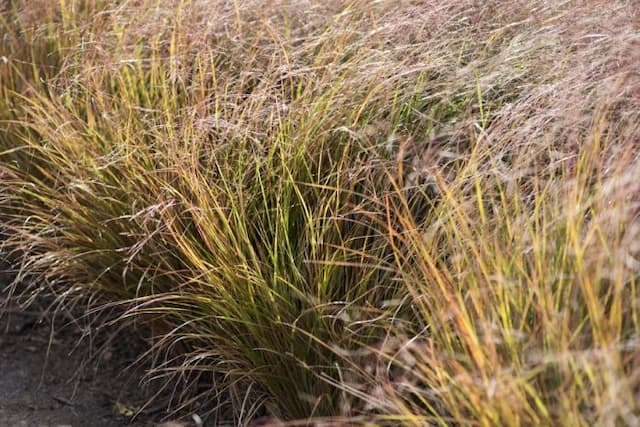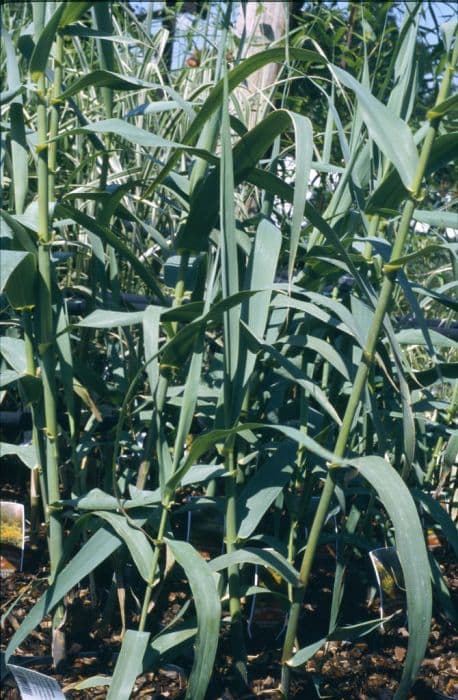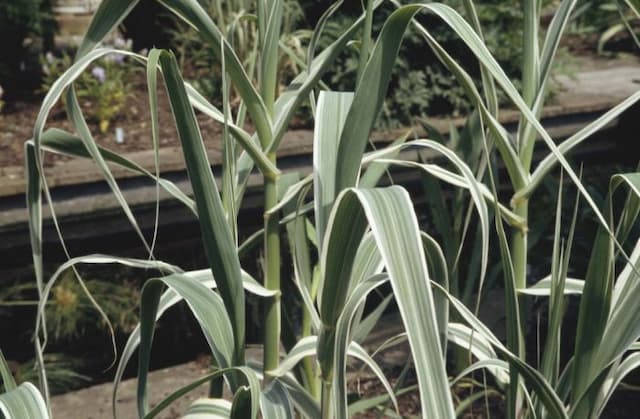Wavy Hair Grass Deschampsia flexuosa 'Tatra Gold'

ABOUT
The plant known as Tatra Gold is a type of ornamental grass with a distinctive appearance. This variety is particularly noted for its vibrant foliage, which displays an eye-catching shade of yellow or gold, especially when the fresh growth emerges in the spring. As the plant matures through the seasons, the golden hues may transition into a yellow-green color, adding a spectrum of warm tones to the landscape across different times of the year. The leaves of Tatra Gold are slender and arch gracefully, creating a soft and flowing texture. This fine foliage forms a tufted mound that adds a lightness to its visual presence in a garden setting. Later in the season, this plant may also produce airy flower panicles that rise above the foliage. These delicate flowering stems bear small flowers that can add a contrast to the golden foliage, with their tones typically ranging in color from silvery-green to purplish. The overall effect of this plant is one of a bright and cheerful presence, which can be used effectively to lighten up darker areas or to introduce a spot of color to a green-dominated landscape. Its appearance makes it popular among gardeners looking to create varied and vivid garden designs without relying on traditional flowering plants.
About this plant
 Names
NamesFamily
Poaceae
Synonyms
Wavy Hair Grass, Crinkled Hair Grass, Tatra Gold Hair Grass
Common names
Deschampsia flexuosa 'Tatra Gold'.
 Toxicity
ToxicityTo humans
Deschampsia flexuosa, commonly known as wavy hair grass, is not known to be toxic to humans. There are no well-documented symptoms of poisoning because it is not considered a poisonous plant. Therefore, ingesting parts of the wavy hair grass is unlikely to cause harm.
To pets
Wavy hair grass is not known to be toxic to pets. It is not considered a poisonous plant, and there are no common reports of pets being poisoned by ingesting this plant. Therefore, ingestion of parts of the wavy hair grass is unlikely to result in toxic consequences for pets.
 Characteristics
CharacteristicsLife cycle
Perennials
Foliage type
Evergreen
Color of leaves
Gold
Flower color
Varies
Height
1-2 feet (30-60 cm)
Spread
1-2 feet (30-60 cm)
Plant type
Grass
Hardiness zones
4-8
Native area
Europe
Benefits
 General Benefits
General Benefits- Ornamental Appeal: Adds visual interest with its bright, golden-green foliage and delicate, airy flower panicles.
- Low Maintenance: Requires minimal care once established, making it a good choice for gardeners of all skill levels.
- Drought Resistance: Can survive in dry conditions, reducing the need for frequent watering.
- Cold Tolerance: Hardy in cold climates, which allows it to thrive in a wide range of temperatures and settings.
- Soil Versatility: Adapts to a variety of soil types, from well-drained sandy soils to clay.
- Wildlife Attraction: The flowers and seeds attract birds and beneficial insects to the garden.
- Erosion Control: Its root system helps stabilize soil on slopes and embankments, preventing erosion.
- Naturalizing: Can spread to form naturalistic drifts, blending well with other plants in wild gardens or meadows.
- Seasonal Interest: Provides year-round interest with evergreen foliage and changes in texture and color throughout the seasons.
- Compact Size: Its small stature makes it suitable for use in borders, rock gardens, and small spaces.
 Medical Properties
Medical PropertiesThis plant is not used for medical purposes.
 Air-purifying Qualities
Air-purifying QualitiesThis plant is not specifically known for air purifying qualities.
 Other Uses
Other Uses- Deschampsia flexuosa 'Tatra Gold', commonly known as Wavy Hair Grass, can be used in floral arrangements for its delicate, airy seed heads that add texture and a golden hue.
- Wavy Hair Grass can be implemented in landscape photography to add a sense of depth and natural beauty, especially with its golden coloring in the light.
- This ornamental grass can serve as a natural dye source, with the potential to color fabrics or materials with hues extracted from the plant.
- Wavy Hair Grass is often used in garden design for creating contrasts against darker foliage plants, enhancing the overall visual impact.
- It can be used as a teaching tool in educational settings to discuss plant adaptation and survival in poor soils.
- This grass type can play a role in erosion control on slopes due to its extensive root system that helps to hold soil in place.
- In crafts, dried seed heads of Wavy Hair Grass can be used to create natural, rustic decorations or add a unique touch to handmade paper.
- Wavy Hair Grass can be grown in containers to bring a touch of wild meadow aesthetic to urban balconies or patios.
- It can be implemented in companion planting to support biodiversity, as it does not compete aggressively with other plants.
- Gardeners can use Wavy Hair Grass to create soft borders along walkways or pathways, providing a flowing, natural edge to garden designs.
Interesting Facts
 Feng Shui
Feng ShuiWavy Hair Grass is not used in Feng Shui practice.
 Zodiac Sign Compitability
Zodiac Sign CompitabilityWavy Hair Grass is not used in astrology practice.
 Plant Symbolism
Plant Symbolism- Nature's Resilience: Deschampsia flexuosa 'Tatra Gold', commonly known as Wavy Hair Grass, often symbolizes resilience due to its ability to thrive in poor soils and withstand challenging conditions.
- Youth and Vitality: The bright 'Tatra Gold' variety, with its vivacious golden-green foliage, represents youth and the invigorating energy of life.
- Growth: Wavy Hair Grass can also be seen as a symbol of growth, both physically, as it spreads and can become a dominant plant in the landscape, and metaphorically, representing personal development over time.
- Flexibility: As the species name "flexuosa" suggests, this plant is flexible and can move with the wind, symbolizing the ability to adapt to changing circumstances without breaking.
- Modesty: Despite its ornamental value, Wavy Hair Grass is not a showy or dominant plant, which can make it represent modesty and unassuming beauty.
 Water
WaterWavy Hair Grass, commonly known as Deschampsia flexuosa 'Tatra Gold', requires consistent moisture, particularly during its growing season in spring and early summer. It should be watered once or twice a week, depending on the climate and soil conditions. If rainfall is scarce, provide the plant with about one to two gallons of water weekly to ensure the soil stays damp but not waterlogged. During the winter months, reduce watering as the plant's growth slows down. Ensure the water penetrates the soil deeply to encourage root development.
 Light
LightWavy Hair Grass thrives best in full sun to partial shade. Ideally, it should receive at least four to six hours of direct sunlight per day. The perfect spot would be one where the plant is exposed to the morning sun but shielded from the harshest afternoon rays, especially in hotter climates.
 Temperature
TemperatureWavy Hair Grass prefers temperatures within the range of 60°F to 75°F but can tolerate temperatures as low as the 40s and as high as the 80s Fahrenheit. It is hardy and can endure frost, but prolonged exposure to temperatures below 40°F may harm the plant. Optimal growth is seen within the preferred temperature range mentioned earlier.
 Pruning
PruningPruning Wavy Hair Grass is usually done for aesthetic purposes or to remove dead foliage. Cut back the foliage in late winter or early spring before new growth emerges. Pruning once a year is often enough, and it is best to remove only spent leaves and stems to maintain the plant's natural shape.
 Cleaning
CleaningAs needed
 Soil
SoilWavy Hair Grass thrives best in a well-draining soil mix with a slightly acidic to neutral pH, ranging from 5.8 to 7.0. A combination of loamy soil, peat moss, and sand or perlite would provide the right texture and nutrients. It is adaptable to various soil types as long as there is adequate drainage.
 Repotting
RepottingWavy Hair Grass typically does not require frequent repotting. It can be repotted once it outgrows its current container or every 2 to 3 years to refresh the soil and divide if necessary.
 Humidity & Misting
Humidity & MistingWavy Hair Grass prefers average humidity levels and does not have specific high humidity requirements, making it suitable for most natural outdoor humidity ranges.
 Suitable locations
Suitable locationsIndoor
Place Wavy Hair Grass near a sunny window and ensure good ventilation.
Outdoor
Plant in a sunny to partial shade spot with good drainage.
Hardiness zone
4-9 USDA.
 Life cycle
Life cycleCrinkled Hair Grass, commonly known as Deschampsia flexuosa 'Tatra Gold', undergoes several key stages in its life cycle. Initially, it begins as a seed, entering a germination process when conditions of temperature, moisture, and light are favorable for growth. After germination, it develops into a seedling, producing the first true leaves and a root system. As it moves into the vegetative stage, 'Tatra Gold' grows taller and develops its characteristic golden-green foliage and forms dense tufts. The reproductive stage follows, during which the plant produces airy, delicate inflorescences that can catch the light, contributing to its ornamental appeal. After setting seed, the plant may go dormant for a period, especially in colder climates, before resuming growth in the following season.
 Propogation
PropogationPropogation time
Spring-Early Summer
The most popular method of propagating Deschampsia flexuosa 'Tatra Gold', also known as Wavy Hair-grass, is through division. The best time to propagate this ornamental grass is in the spring, when new growth begins to appear. To propagate by division, dig up an established clump of Wavy Hair-grass and gently separate it into smaller sections with your hands or with the use of a sharp knife. Each section should have a portion of the root system and several growing points. These divisions can then be replanted into the prepared soil, ideally spaced out by about 12 inches (approximately 30 centimeters) to allow sufficient room for growth. Water the new plants well to help them establish in their new locations. This method is efficient and maintains the varietal characteristics of the parent plant.









